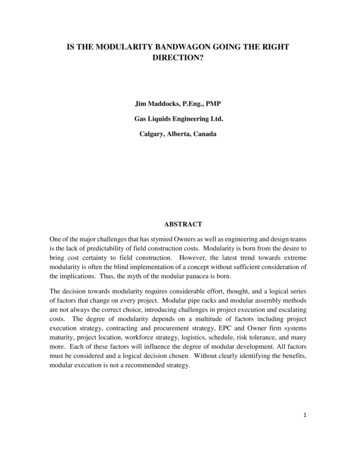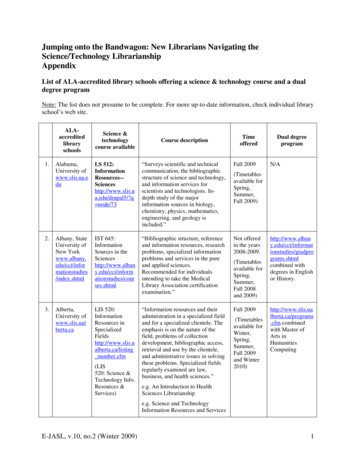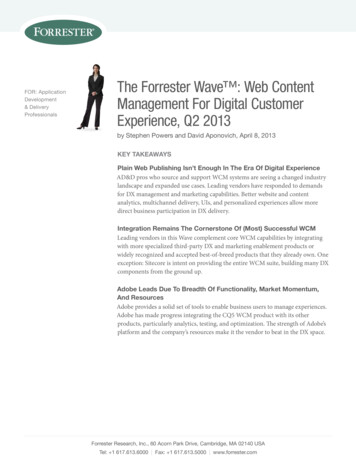
Transcription
IS THE MODULARITY BANDWAGON GOING THE RIGHTDIRECTION?Jim Maddocks, P.Eng., PMPGas Liquids Engineering Ltd.Calgary, Alberta, CanadaABSTRACTOne of the major challenges that has stymied Owners as well as engineering and design teamsis the lack of predictability of field construction costs. Modularity is born from the desire tobring cost certainty to field construction. However, the latest trend towards extrememodularity is often the blind implementation of a concept without sufficient consideration ofthe implications. Thus, the myth of the modular panacea is born.The decision towards modularity requires considerable effort, thought, and a logical seriesof factors that change on every project. Modular pipe racks and modular assembly methodsare not always the correct choice, introducing challenges in project execution and escalatingcosts. The degree of modularity depends on a multitude of factors including projectexecution strategy, contracting and procurement strategy, EPC and Owner firm systemsmaturity, project location, workforce strategy, logistics, schedule, risk tolerance, and manymore. Each of these factors will influence the degree of modular development. All factorsmust be considered and a logical decision chosen. Without clearly identifying the benefits,modular execution is not a recommended strategy.1
1. INTRODUCTIONIn order to discuss modularity, it’s important to start with a common understanding. Earlygas plants in the 60’s and 70’s utilized a “stick-built” type of construction methodology.Plants were designed by large, heavy manpower, EPC design firms. In this conventionalmethodology, the facility process design was usually completed by either the EPC firm orthe Owner’s engineering team directly. This was more applicable in the days of large ownerbased engineering teams that existed in companies like Dome, Amoco, Chevron, Mobil, etc.Usually the EPC firm then performed detailed engineering and designed the vessels,exchangers, piping, control valves, compression, and other process equipment. Once thatdesign was complete, the EPC firm (or the owner) would go out for bid for the equipment.They would receive bids for exchangers, towers, reboilers, separators, compressors, pumps,and other process equipment. Then, the designer would essentially “put the pieces together”using stick built technology. This included large concrete foundations, large field erectedcompressor buildings (often 100’s of feet long), field-fabricated structural pipe racks andpiping and installation of a large amount of owner purchased instrumentation like meters,control valves, hand valves, and other auxiliary equipment. Finally, they issued a series ofisometric drawings to the contractor who then fabricated, tested and installed the piping inaccordance with the published project specifications. The pipe, valves, and fittings wereprocured either by the owner or by the EPC firm. While this technology still persists in someparts of the world and in some projects, most (if not all) gas plant projects are beingcompleted with some level of modularity.In the late 70’s and early to mid 1980’s, modularity began booming when fabricators anddesigners began installing equipment and piping onto skidded packages. These “skids”allowed for a much easier installation of the equipment and started the progression ofcontractors from complete turnkey type of contracting into module assembly contractors.Plant sizes and complexity decreased, and the economics for smaller, faster, and low cost gasprocess plants became favorable. Finally, with the onset of large Alberta mega projects,2
many Owners and EPC companies moved towards complete modularity with large multi-tonpiperacks.Figure 1 - Modular Pipe Rack2. DEFINITIONSIn order to discuss modularity, it’s important to begin from the same point of reference.Modularity can, in a broad case, cover any type of pre-packaged equipment where the fieldcontractor can install this as a pre-completed unit.Package ModularityPackage modularity can take many forms in the current market. It is very common (andexpected) that shops will pre-package many of the components like separation modules,compression packages, process packages, and utility packages. These “packages” oftencome out of the shop with equipment mounted, spooled, tested (often even test run), andmounted inside a building for remote environments. In most cases, this module is a singlepurchase order to the fabrication shop(s) and consists of a series of discipline work includingprocess design, piping, vessels, exchangers, towers, controls, wiring, and abuilding/enclosure. The packages are shipped to site in a semi-complete manner, and thecontractor is then expected to re-assemble the final package, and perform the final hookupsto make the system operationally ready for commissioning. This type of pre-packaged or3
shop labored package is the basic definition of modular. Depending on shop capability andscheduling/transportation limitations, the packages may come out pre-wired with a buildingor they may come out bare to the field requiring more assembly and a higher degree ofmodule completion in the field. This is due to a number of reasons including:a) Logistics: Where the single package is outside the allowable shipping envelope.i.e. The truck is unable to cross a final bridge during the shipping or fit inside roadlimits.b) Logistics: Where the package must be shipped within a certain time frame or acertain area having constraints (i.e., caribou season, winter roads, ice bridges,tourist season, and road bans).c) Equipment Considerations: Where the components are too large, too tall, or tooawkward to mount inside the package prior to shipping. (i.e., delicate equipmentthat may require special shipping considerations, large, awkward equipment thatis too big once it’s packaged, or heavy equipment that becomes difficult to movein a conventional manner).d) Schedule: Late or extended delivery from a vendor may prevent the packagecompletion – these late pieces may be shipped separately and will requireinstallation in the field.e) Owner supplied equipment: Pieces that the owner may have purchased directlyand elects to install at the final project location. This could include expensive,delicate, or difficult to procure equipment.Rack ModularityAdditional elements of modularity may include completely fabricated and assembled piperacks. These modular pipe racks are often pre-assembled into large, multi-tiered sections(40-150 meters long), and shipped to site for the site contractor to install onto preparedfoundations. The racks often contain multiple levels of piping, structural steel, and cabletrays. Depending on the degree of modularity that takes place, the module could containinstrument wiring, insulation, heat tracing, lighting, and other traditionally site-contractedelements. Rack piping can be left as bare steel ready for welding or flanged and ready forhookup in the field. UT testing and hydrotesting of the piping can take in the shop (on a permodule basis) but the final welds and hookup must be hydro-tested on site.When we talk modularity, it’s important to use a single frame of reference – the use of theterm modular is general, misleading, and often misapplied.4
3. GOALS OF MODULARITYThe thrust towards modularity is driven by a number of factors. We’re going to examinethese separately.1.) Costs:a. The desire for predictable, estimatable and consistent field labour costsand scheduling.b. The desire to transition field hours into shop hours. This is probably thesingle largest prize and allows the direct reduction of:i. Site man-hour costs,ii. Site indirect costs associated with a larger workforce,iii. Travel time and associated costs,iv. Subsistencec. The desire to access a larger, potentially less skilled workforce that canassemble “plug and play” blocks as opposed to a limited resource baseperforming a highly skilled work activity requiring extensive experienceand oversight.d. Minimization of labour in remote locations or locations where a workforcecan’t be mobilized easily. i.e., helicopter access for construction crews.e. Reduction of field over-runs, mistakes, and RFI’s.f. Transition pipe racks into a commodity capable of being procured viasupply chain management.g. Increased productivity in a controlled environment.2.) Safety:a. The use of extensive, large/multi-discipline, and a potentially lessexperienced site workforce, will inevitably mean a larger amount of safetyincidents, and a higher degree of risk to the workforce on site. While thisis a direct function of man-hours, it is also exacerbated with activities likescaffolding, high level structural work, and high level pipe rack workinvolving welding, insulation, heat tracing, and wiring.b. Weather related incidents3.) Performance:a. The desire for reduced cycle times, faster on-stream times, and less fieldtime. While this directly connects to costs, it also reduces site traffic,reliance on multiple 3rd party contractors, exposure to inclement weather,and long delays associated with missing equipment or late deliveries.4.) Repeatabilitya. A desire to capitalize on a phased type of development where the “designone – build many” type of environment becomes dominant.5
COSTSThis remains the single largest prize that is forcing modularity. No matter the class ofestimate, construction costs (structural/mechanical/electrical) remain the largest, mostunpredictable item. With these items exceeding 30% of the facility budget in many plantdesigns, certainty and predictability is critical. Project budget overruns are common in megaprojects, and with this comes the loss of schedule and project control. The trend to issuingengineering drawings and construction work packages just-in-time have forced many fieldactivities onto the critical path. A single delay, a single piece of equipment, or a single pieceof missing information can trigger long delays, out of sequence construction, and a resultingcost escalation. According to published papers1, nearly 70% of oil and gas mega projects areclassified as failures where they failed to either meet schedule requirements or experiencedsignificant cost over-runs.In the project budgeting world, estimating field construction costs during a project definitionstage is very difficult. Poor definition, lack of information, and an often compressedschedule, makes the definition of field costs difficult if not a guess. Owners do not want tohear this. Rightly so, they are seeking cost certainty and with it, schedule certainty. Oneway to achieve this is to force a portion of the field construction hours back into a shopenvironment where they can be executed for lower costs. Reducing site costs will mean asmaller, more manageable site workforce, reduced travel and subsistence costs, and ashortened construction work schedule.The move to modular racks means that systems, procedures, and even site work activitiesbecome predictable which makes them estimatable and repeatable. This is the heart of themodularity concept – turning traditional field activities into shop based activities will makecosts and schedule more predictable. This will, when done properly, reduce field RFI’s,compress construction schedules, and allow for a reduction in site workforce – the singlelargest contributor to costs on a typical large project. Many large projects (prior to the oilprice collapse) were expected to have difficulty sourcing a sufficient workforce that wouldallow them to complete the project on schedule. While this issue has temporarily beensolved, an oil price recovery would actually make this problem worse when multiple projects,most currently on hold, kick off at a frantic pace.1Edward Merrow, Independent Project Analysis, IPAGlobal, 2011, Restoring Owner Confidence in Alberta’sCapital Effectiveness.6
This modular rack concept also turns the racks into a relatively simply, procurement basedactivity. Thus, the work of rack construction becomes a supply chain function albeit withsignificant engineering and design input.SAFETYThe importance of safety cannot be ignored. Large work forces generate the potential forincreased frequency of safety incidents. The lack of a locally available, sufficiently skilledworkforce means that many contractors may have to recruit unskilled labor or workforcesthat do not have the necessary facility construction skillsets. The higher degree of risk witha larger workforce, means an increase in incidents. While this is inevitable with larger, lessskilled work forces, rack modularity will reduce this propensity for workplace safetyincidents by:a) Reducing field hours and workforce.b) Modifying the type of work that must be completed at the field level.Traditional, stick built facilities, involved a large workforce, long duration, man-hour heavyactivities, with much of it taking place at elevated heights on complex multi-tier racks. Whilemodular rack technology doesn’t completely eliminate this, the use of prefabricated rackscertainly minimizes the amount of hours that must be completed at elevations other thangrade. Rack bolting, power cabling, welding, and system completion still require significantwork efforts at less than ideal heights.SCHEDULE AND CYCLE TIMESSimilar to project costs, construction durations, predictability, and estimated completion havesuffered during recent project developments. This unpredictability is coupled to the costuncertainty and causes owners a considerable amount of grief. Often, engineering is “fasttracked” to issue less than complete construction packages or staged issues – often missingcritical information. This makes it almost impossible for the construction organization andthe Owners CM teams to estimate completion dates or costs with any degree of certainty.Owners are looking for faster execution, faster cycles, and above all, they want predictability.The use of modular racks, while not providing a complete assurance of construction costs,can provide a higher level of surety on costs, execution, and scheduling. Ideally, the rack ormodular concept will turn the plant construction model into a factory build style with repeatefforts, predictable workfaces, and familiar construction techniques. This will reduce fieldconstruction times as long as the modular interface and development style doesn’t actuallyincrease the detail, level of work required or add to the complexity.REPEATABILITY7
In many cases, the move to modularity is driven by owners who intend to transition theirdesign and construction teams into a series of repeatable projects. Rather than custom designeach facility, the Owner elects to move into a “build and repeat” mode in which layouts arecopied, plant designs are copied, and construction work practices are identical from job tojob. This repeated work planning, essentially an assembly line type of practice, should allowfor lower costs, faster cycles, and reduced errors as well as reduced potential for site safetyincidents. This “factory-model” based work practice could allow for less skilled labour, acheaper workforce, and ultimately, should turn successive construction worksites into acommodity based system.This isn’t always achievable for a number of varying reasons, but this is an oft repeated goalof modularity In many cases, this results in a different contractual structure with a repeatedmodel. While this should reduce cycle times as well as saving contractual costs, the inherentlink to a particular contractor or module fabricator requires diligence and control.4. HOW IS MODULARITY PRACTICEDIn order to fully understand the modularity discussion, a brief overview of how modularityis practiced and some of the evolution of modularity is required.Early attempts at modularity were based solely on short, single tier racks, typically 10-12meters in length. Simplistic modules were strictly the structural steel skeleton that could beshipped to site on trucks, lifted and placed onto piles or foundations. These allowed the shopfabrication of structural steel and started to minimize the degree of field structural work thatwas required. This module package was often completed by structural steel fabricationshops.The next generation of module pipe racks started to include multi-level tiered racks with preloaded piping. This piping was often completed in the module yard and the entire modulewould be shipped semi-complete with the module lifted and locked into place. Once thepiping was integrated into the module, the type of modular contractor needed to adapt into aprovincially licensed piping fabrication group with a registered quality program. Modulesare arranged with either pre-flanged ends or bare pipe ends. With flanged ends, it is possibleto pre-test all components prior to module shipment. Any changes in the field will require anisolated spool to require re-testing. When bare ends are utilized and test plugs used tohydrotest in the yard, “golden (closure)” welds were traditionally used to allow insulationand heat tracing to occur in the module yard. Closure welds can be difficult to receiveregulatory approval for as some operators used them frequently and outside of the parametersof the original intent. Hydro-testing of the entire piping system is now most commonlyrepeated in the field.8
Further generational shifts occurred with the installation of cable trays, walkways, lifelines,insulation, heat tracing, and finally control/communications cabling. Each of these elementsadds a layer of complication to the module construction but eliminates (partially or totally)these activities from the field construction level. Obviously the modules must be sufficientlystrong enough for lifting, transportation, and setting while containing all the necessaryelements. In addition to this, the increased complexity has forced module shops to adapt tonewer technologies, newer more advanced methods, and to integrate with multiple skill sets.Figure 2 - Highway Module Shipping5. ADVANTAGES OF MODULARITYThe use of pipe rack modules has triggered a number of advantages that bear repeating.Plant Layout – Modules can allow for a more consistent layout, a more repeatable plantlayout and can allow for future flexibility when necessary. While some moduleproponents claim a more compact layout, this isn’t necessarily true. Conventional orhybrid methods can provide similar benefits when done properly. Standard racks can beessentially pre-built and stored for use in expansions or similar plot plan facilities.Weather Impact – The use of modules can reduce the weather impact on fieldconstruction teams. While the modules don’t completely reduce the impact of adverseweather on construction teams, the reduced field craft hours will mean a reduced9
probability of poor weather exposure on the facility jobsite. Depending on the style ofmodule construction, module yard labour forces may still be exposed to inclementweather.Labour – The use of modules will reduce the reliance or the need to source a large locallabour force that may be semi-skilled. This is a significant benefit. As well, in caseswhere module yards are close to large urban centers, access to materials, tools,technology, and labour resources are considerably easier.Quality – While many field construction jobs have very low rework rates, a shop basedmodule should, when completed properly by a qualified module yard, provide a higherassurance of quality in the finished product. Integration with the final constructioncontractor is essential in understanding the interface for QA.Reduced Workforce – A smaller workforce on site, will mean fewer contractor conflicts.While this isn’t always a factor in construction projects, there are always competingpriorities for access to areas, work fronts, and equipment. Ideally, the smaller work forceshould mean reduced contractor conflicts where multiple contractors need to the sameconstruction work area. Unfortunately, it may work out the exact opposite as teams(mechanical, electrical, and others) are now time and space constrained to completemodule hook-up quickly – often simultaneously.Lower Cost – The use of modular shops can potentially use a skilled workforce fromanother country or another resource area where there is no shortage of labour or wherethe labour costs may be significantly lower. Obviously, lower labour costs must bebalanced out with transportation, logistics, expediting risks. Depending on project sitelocation, it is possible to procure modules from virtually anywhere – many tidewaterlocations can provide easier access to huge, low cost labour forces with considerablemodule experience.Reduced Traffic – A smaller workforce will reduce the level of traffic on access roads,reduce the probability of traffic based incidents and will alleviate congestion on site.Depreciation – Given that rack modules become a semi-standard commodity, it’sconceivable that the modules can be depreciated at a rate similar to process equipment.This may provide some easing of tax issues and could allow an owner to depreciate moreof the facility at a more attractive capital cost allowance rate.Conversion to a commodity – The conversion of piperack modules has turned this pieceof traditional construction work into a standard (albeit engineered) product. It generatesthe practice of multiple, competitive bids and competing deliveries (presumably fromqualified vendors) and can allow the use of anyone’s modules in a construction project.10
Ultimately, this change to a commodity can reduce the reliance on a single contractor forthe balance of the work. This can provide a significant benefit for the project (cost andschedule) as a major portion of site labour hours is shifted to the module yard. Dependingon module yard location, it will be easier to visit the location, easier to maintain a qualityand inspection test plan, and easier for shipping firms to provide input on the finalproduct.Timing – In most construction projects, a number of near-simultaneous work activitiestake place at the end of the project prior to commissioning. While these vary based onfacility design and complexity, controls and heat tracing completion as well as theinstallation of insulation are almost always the final construction elements. Forcing muchof this work back to the modular shop/yard can reduce the reliance on the site contractorsfor final construction. In many cases, controls and instrumentation can be pre-wired tomodule based junction boxes that allow for loop checking of the module prior to shipping.Flexibility – In many cases, Owners are planning for and constructing identical facilitiesusing the D1BM – “Design one, build many” concept. Depending on the design concepts,a standardized rack module could be developed, pre-built and stored for eventual factorymodel type of execution. Ultimately, the Owner could store multiple modules, completeand ready for trucking/hookup at a central storage yard. Module racks and modularsystem can be beneficial in “brownfield” types of facility work where space is sometimespinched or where there is a desire to minimize people on site in an operating facility.However, in some brownfield designs, modularity may not be possible due to the natureof the work.6. DISADVANTAGES OF MODULARITYWhile there are a large number of advantages, the use of modularity is not a general panaceafor construction projects. Modularity must be reviewed carefully, and should be selectedwhen the benefits outweigh the potential risks. For several years, modularity has enjoyedconsiderable popularity, and in many cases, has been selected as a desirable constructionmethod without sufficient forethought. In some cases, the selection of modularity is drivenby peer pressure, buzzwords, and engineering/construction teams trying to achieve acompetitive advantage. In many cases, the disadvantages or drawbacks are insufficientlyanalyzed before the decision is made. In addition to this, the decision to “go modular” isoften made without a sufficient analysis of the labour market availability. As a consequence,this modular decision is poorly thought, not reversible and ultimately has majorconsequences on the cost and/or scheduled results.11
Figure 3 - Modular Pipe Rack w Weld SheltersMaterialsThe use of true modular rack systems involve considerable structural steel. In manycases, this increased structural steel portion is required for shipping integrity, liftingutilization, and overall strength. The module rack/cage will require cross bracing,stringers, lifting elements, and support structures to allow for rapid deployment of theracks. This increased structural mass is an additional design consideration required forfoundation designs. In discussions with several contractors, it’s estimated that structuralsteel weight/cost will increase 20-30% over a traditional non-mod construction project.The larger the module, the less this has an effect as the larger modules become essentiallyself-supporting through multiple tiers of piping and racks.Usually the Owner elects to procure and free-issue pipe, valves and fittings to the moduleyard. However, the module fabricator can also procure the materials given adequatespecifications. In cases where the module fabricator procures the materials, an additionalreceiving and quality assurance step is assumed by the module yard. Additional materialsinclude clamps, supports, cable tray, insulation/jacketing, tracing (electrical orfluid/steam based) and end-kits where necessary.In every case, the module fabricator should be issued a set of project specifications thatoutline the requirements and expectations for module quality, structural steel, receiving,12
storage, handling, preparation, and fabrication of the structural steel cages. Completematerial traceability is essential for all equipment and materials.Module FabricationWhile the goal of modularity is reducing field construction labour hours, this labour stillneeds to be performed. In most cases, the modules are fabricated and assembled outsidein yards near major labour centers. This doesn’t totally reduce the weather factor.Outside of fabrication in remote locations (like SE Asia), weather will almost always bea factor. Module yards may not have in-house labour for skilled sets like insulation andtracing; these labour functions may need to be sub-contracted.InterfaceInterface management is critically important in modular execution. Multiple contractors,multiple EPC firms, and sometimes even multiple module yards, can make any projectchallenging in determining scope, XYZ locations, timing, shipping, and coordination ofefforts. In addition to this, managing equipment supply firms and verification of hookupdetails is important in managing modules. This interface management work effort is notinsignificant and must be managed and budgeted properly.ShippingNo modular project is complete without a serious work effort focused on expediting,shipping and logistics. This includes routing studies, road bans/limits, cranes, shippinglimits, bridges, lifting plans, and finally hauling equipment during inclement weather.Larger modules may require the use of SPMT (self-propelled modular transports) formoving modules onto the prepared foundations. Depending on the timing, it may benecessary to have a large module storage/staging areas although multiple lifts are notdesirable.WeldingIn order to provide for modular interconnection, several options are available. Thesimplest method is to pre-flange the ends of the pipe spools to allow for an easierinterconnect. This method allows for pre-testing of all rack spools and is an easierhookup than welding. The weld-end method include leaving a pipe stub at the end ofeach rack to allow welding to take place. While flanges allow for easier assembly, thecost of the flanges, an additional weld, and bolting kits can add costs while still notproviding 100% containment. In theory, rack spools could be pre-tested with either pipecaps or inflatable plugs but the final connection weld would still require NDT and retesting. Depending on the commodity in the piping, some Owners may require both13
methods on the same module. Recent technology has utilized an orbital welding systemthat speeds up the welding process, requires minimal clearance and improves weldconsistency. Figure 2 picture shown above has the welding shelters integrated into therack module during hookup.Shop QAAn important modular consideration is the need for effective, reliable shop inspectionand quality management for the modular fabrication process. In order to benefit from themodule concept, the modules must fit in place, be secure on the foundations, and thepiping must match from module to module. Changes to the modules in the field to correctdimensions or installation issues will be costly and time consuming. This QA cost andshop inspection work must be incorporated in the project work plan.Module InstallationIdeally, the modules will be trucked to site, either direct from the module yard or from astaging location, and then offloaded directly onto the prepared foundations. This mayrequire specialized and costly lifting and transportation equipment. Given the size of themodules, a 1600 ton crane may cost up to 1,000,000 to mobilize to site. Such a largesite crane must be well-managed and well-utilized to prevent excessive downtime andcosts. In addition to this, the crane and lifting equipment will be footprint intense andwill require site security and specialized manpower for operation and maintenance. Asseen in Figures 3 & 4 below, significant planning and crane access considerations mustbe left for module setting. This can have a major effect on construction sequencing –particularly if equipment is late getting to site. This equipment may require pre-bookingor some form of commitment to lock down the availability.14
Figure 4 - Major Module LiftTiming/SequencingWhile the timing and sequenci
Rack Modularity Additional elements of modularity may include completely fabricated and assembled pipe racks. These modular pipe racks are often pre-assembled into large, multi-tiered sections (40-150 meters long), and shipped to site for the site contractor to install onto prepared foundations.










